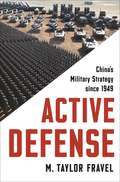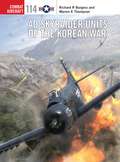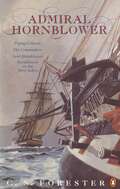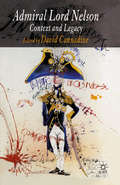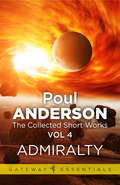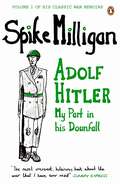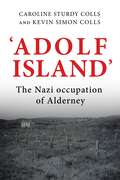- Table View
- List View
Active Defense: China's Military Strategy since 1949 (Princeton Studies in International History and Politics #167)
by M. Taylor FravelWhat changes in China’s modern military policy reveal about military organizations and strategySince the 1949 Communist Revolution, China has devised nine different military strategies, which the People’s Liberation Army (PLA) calls “strategic guidelines.” What accounts for these numerous changes? Active Defense offers the first systematic look at China’s military strategy from the mid-twentieth century to today. Exploring the range and intensity of threats that China has faced, M. Taylor Fravel illuminates the nation’s past and present military goals and how China sought to achieve them, and offers a rich set of cases for deepening the study of change in military organizations.Drawing from diverse Chinese-language sources, including memoirs of leading generals, military histories, and document collections that have become available only in the last two decades, Fravel shows why transformations in military strategy were pursued at certain times and not others. He focuses on the military strategies adopted in 1956, 1980, and 1993—when the PLA was attempting to wage war in a new kind of way—to show that China has pursued major change in its strategic guidelines when there has been a significant shift in the conduct of warfare in the international system and when China’s Communist Party has been united.Delving into the security threats China has faced over the last seven decades, Active Defense offers a detailed investigation into how and why states alter their defense policies.
Active Defense: China's Military Strategy since 1949 (Princeton Studies in International History and Politics #167)
by M. Taylor FravelWhat changes in China’s modern military policy reveal about military organizations and strategySince the 1949 Communist Revolution, China has devised nine different military strategies, which the People’s Liberation Army (PLA) calls “strategic guidelines.” What accounts for these numerous changes? Active Defense offers the first systematic look at China’s military strategy from the mid-twentieth century to today. Exploring the range and intensity of threats that China has faced, M. Taylor Fravel illuminates the nation’s past and present military goals and how China sought to achieve them, and offers a rich set of cases for deepening the study of change in military organizations.Drawing from diverse Chinese-language sources, including memoirs of leading generals, military histories, and document collections that have become available only in the last two decades, Fravel shows why transformations in military strategy were pursued at certain times and not others. He focuses on the military strategies adopted in 1956, 1980, and 1993—when the PLA was attempting to wage war in a new kind of way—to show that China has pursued major change in its strategic guidelines when there has been a significant shift in the conduct of warfare in the international system and when China’s Communist Party has been united.Delving into the security threats China has faced over the last seven decades, Active Defense offers a detailed investigation into how and why states alter their defense policies.
Active Defense: China's Military Strategy since 1949 (Princeton Studies in International History and Politics #167)
by M. Taylor FravelWhat changes in China’s modern military policy reveal about military organizations and strategySince the 1949 Communist Revolution, China has devised nine different military strategies, which the People’s Liberation Army (PLA) calls “strategic guidelines.” What accounts for these numerous changes? Active Defense offers the first systematic look at China’s military strategy from the mid-twentieth century to today. Exploring the range and intensity of threats that China has faced, M. Taylor Fravel illuminates the nation’s past and present military goals and how China sought to achieve them, and offers a rich set of cases for deepening the study of change in military organizations.Drawing from diverse Chinese-language sources, including memoirs of leading generals, military histories, and document collections that have become available only in the last two decades, Fravel shows why transformations in military strategy were pursued at certain times and not others. He focuses on the military strategies adopted in 1956, 1980, and 1993—when the PLA was attempting to wage war in a new kind of way—to show that China has pursued major change in its strategic guidelines when there has been a significant shift in the conduct of warfare in the international system and when China’s Communist Party has been united.Delving into the security threats China has faced over the last seven decades, Active Defense offers a detailed investigation into how and why states alter their defense policies.
Active Electronically Scanned Arrays: Fundamentals and Applications (IEEE Press)
by Arik D. BrownAn Introduction to Active Electronically Steered Array Fundamentals, provides a foundational introduction to Active Electronically Steered Arrays (AESAs). It is intended for professional engineers and engineering students who are new to AESAs. The book provides an overview of the primary subsystems of an AESA, detailed explanation of the key design concepts and fundamentals for each subsystem and concludes with performance results for various AESA architectures that are typically found in industry (Analog AESAs, Subarrayed AESAs, and Digital Beamforming AESAs). Topics covered in the book include: • AESA Overview • Antenna Array Elements • Transmit/Receive Modules • Beamformers • Downconverters • Exciters • Receivers • Performance for Different AESA Architectures The book provides a conceptual understanding of the key subsystems that comprise an AESA that is not found in another book. It is based upon the author's 20 years of experience developing, designing and building AESAs for RADAR, SIGINT, Comms and Electronic Warfare. The reader of this book will be able to apply the fundamentals discussed in their daily profession.
Active Electronically Scanned Arrays: Fundamentals and Applications (IEEE Press)
by Arik D. BrownIn Active Electronically Scanned Arrays: Fundamentals and Applications, electromagnetics expert Dr. Arik D. Brown delivers a foundational treatment of active electronically scanned arrays (AESAs) ideal for engineering students and professionals. The distinguished author provides an overview of the primary subsystems of an AESA and detailed explanations of key design concepts and fundamentals for subsystems, including antenna array elements, transmit/receive modules, and beamformers. Performance results for various AESA architectures often found in industry, including analog, subarrayed, and digital beamforming AESAs, are discussed. With a focus on practical knowledge and applications, Active Electronically Scanned Arrays: Fundamentals and Applications offers an accessible overview of a technology critical to the implementation of collision avoidance in cars, air surveillance radar, communication antennas, and defense technologies. The book also includes: A thorough introduction to AESAs, including a top-level block diagram view and explanations of key components and subsystems Detailed explanations of the impact of AESAs on mission applications including Radar, Electronic Attack (EA), Electronic Support Measures (ESM), SIGINT and Communications Comprehensive explorations of antenna array elements, transmit/receive modules, and beamformers including their purpose, functions, and practical design considerations In-depth examinations of AESA architecture performance for current and future systems Utility of AESAs for implementing adaptive beamforming for Electronic Counter-Countermeasures (ECCM) Perfect for electrical engineers working with active electronically scanned arrays, electronic warfare technologies, radar, or communications, Active Electronically Scanned Arrays: Fundamentals and Applications will also prove to be an invaluable resource for defense students undertaking military education and training.
AD Skyraider Units of the Korean War (Combat Aircraft #114)
by Jim Laurier Rick Burgess Gareth Hector Mr Warren ThompsonThe Douglas AD Skyraider is considered the most effective naval aircraft of the Korean War despite the emergence of new jet fighters that captured public imagination. Built to replace the World War 2 workhorses like the Dauntless, Helldiver and Avenger diveand torpedo-bombers, the Skyraider operated numerous combat missions from carrier decks and from US Marine Corps land bases throughout the conflict. Drawing from personal interviews with AD pilots, the authors paint a harrowing picture of the deadly combat of this often forgotten air war as pilots took on Chinese and North Korean forces during daring night attacks and whilst outnumbered in daytime attacks.
AD Skyraider Units of the Korean War (Combat Aircraft)
by Jim Laurier Warren Thompson Rick Burgess Gareth HectorThe Douglas AD Skyraider is considered the most effective naval aircraft of the Korean War despite the emergence of new jet fighters that captured public imagination. Built to replace the World War 2 workhorses like the Dauntless, Helldiver and Avenger diveand torpedo-bombers, the Skyraider operated numerous combat missions from carrier decks and from US Marine Corps land bases throughout the conflict. Drawing from personal interviews with AD pilots, the authors paint a harrowing picture of the deadly combat of this often forgotten air war as pilots took on Chinese and North Korean forces during daring night attacks and whilst outnumbered in daytime attacks.
Adaptation under Fire: How Militaries Change in Wartime (Bridging the Gap)
by Nora Bensahel Lt. General David BarnoA critical look into how and why the U.S. military needs to become more adaptable. Every military must prepare for future wars despite not really knowing the shape such wars will ultimately take. As former U.S. Secretary of Defense Robert Gates once noted: "We have a perfect record in predicting the next war. We have never once gotten it right." In the face of such great uncertainty, militaries must be able to adapt rapidly in order to win. Adaptation under Fire identifies the characteristics that make militaries more adaptable, illustrated through historical examples and the recent wars in Iraq and Afghanistan. Authors David Barno and Nora Bensahel argue that militaries facing unknown future conflicts must nevertheless make choices about the type of doctrine that their units will use, the weapons and equipment they will purchase, and the kind of leaders they will select and develop to guide the force to victory. Yet after a war begins, many of these choices will prove flawed in the unpredictable crucible of the battlefield. For a U.S. military facing diverse global threats, its ability to adapt quickly and effectively to those unforeseen circumstances may spell the difference between victory and defeat. Barno and Bensahel start by providing a framework for understanding adaptation and include historical cases of success and failure. Next, they examine U.S. military adaptation during the nation's recent wars, and explain why certain forms of adaptation have proven problematic. In the final section, Barno and Bensahel conclude that the U.S. military must become much more adaptable in order to address the fast-changing security challenges of the future, and they offer recommendations on how to do so before it is too late.
The Adaptive Military: Armed Forces in a Turbulent World
by James BurkWhen the cold war ended, many hoped it signified enhanced prospects for a more stable world. However, despite favorable political developments, the post-cold war period has been marked by turbulence, uncertainty, and challenge. The actions of rogue states such as Iraq and North Korea have made nuclear proliferation more unpredictable. Violence in Somalia and Bosnia has cast doubt on the viability of international peacekeeping arrangements. Hopes for expanding democratization have been dimmed by assertions that the values of liberal democracy and human rights are incompatible with non-Western cultures. The Adaptive Military describes how military security policies and practices have adapted to these new times and explains why such changes are necessary.The central argument is that current conflicts have been shaped by long-term trends, which increased the number and complexity of threats that the developed world is supposed to meet, and correspondingly decreased the stock of social and political options available to meet them.Although the authors differ in their assessments about the current prospects for peace and ways to maintain security, the issues they address are as critical as they were at the end of the Cold War. Mobilizing resources and political support for remote and difficult enterprises will always remain contentious, but if we recognize the hazard of letting violence run unopposed throughout the world, then we bear some responsibility to consider how it might be checked. This volume is an exercise of that responsibility. It will be of great interest to experts in military studies and international relations.
The Adaptive Military: Armed Forces in a Turbulent World
by Peter Jordan Caroline LloydWhen the cold war ended, many hoped it signified enhanced prospects for a more stable world. However, despite favorable political developments, the post-cold war period has been marked by turbulence, uncertainty, and challenge. The actions of rogue states such as Iraq and North Korea have made nuclear proliferation more unpredictable. Violence in Somalia and Bosnia has cast doubt on the viability of international peacekeeping arrangements. Hopes for expanding democratization have been dimmed by assertions that the values of liberal democracy and human rights are incompatible with non-Western cultures. The Adaptive Military describes how military security policies and practices have adapted to these new times and explains why such changes are necessary.The central argument is that current conflicts have been shaped by long-term trends, which increased the number and complexity of threats that the developed world is supposed to meet, and correspondingly decreased the stock of social and political options available to meet them.Although the authors differ in their assessments about the current prospects for peace and ways to maintain security, the issues they address are as critical as they were at the end of the Cold War. Mobilizing resources and political support for remote and difficult enterprises will always remain contentious, but if we recognize the hazard of letting violence run unopposed throughout the world, then we bear some responsibility to consider how it might be checked. This volume is an exercise of that responsibility. It will be of great interest to experts in military studies and international relations.
The Addis Ababa Massacre: Italy's National Shame
by Ian CampbellIn February 1937, following an abortive attack by a handful of insurgents on Mussolini's High Command in Italian-occupied Ethiopia, 'repression squads' of armed Blackshirts and Fascist civilians were unleashed on the defenseless residents of Addis Ababa. In three terror-filled days and nights of arson, murder and looting, thousands of innocent and unsuspecting men, women and children were roasted alive, shot, bludgeoned, stabbed to death, or blown to pieces with hand-grenades. Meanwhile the notorious Viceroy Rodolfo Graziani, infamous for his atrocities in Libya, took the opportunity to add to the carnage by eliminating the intelligentsia and nobility of the ancient Ethiopian empire in a pogrom that swept across the land. In a richly illustrated and ground-breaking work backed up by meticulous and scholarly research, Ian Campbell reconstructs and analyses one of Fascist Italy's least known atrocities, which he estimates eliminated 19-20 per cent of the capital's population. He exposes the hitherto little known cover-up conducted at the highest levels of the British government, which enabled the facts of one of the most hideous civilian massacres of all time to be concealed, and the perpetrators to walk free.
The Addis Ababa Massacre: Italy's National Shame
by Ian CampbellIn February 1937, following an abortive attack by a handful of insurgents on Mussolini's High Command in Italian-occupied Ethiopia, 'repression squads' of armed Blackshirts and Fascist civilians were unleashed on the defenseless residents of Addis Ababa. In three terror-filled days and nights of arson, murder and looting, thousands of innocent and unsuspecting men, women and children were roasted alive, shot, bludgeoned, stabbed to death, or blown to pieces with hand-grenades. Meanwhile the notorious Viceroy Rodolfo Graziani, infamous for his atrocities in Libya, took the opportunity to add to the carnage by eliminating the intelligentsia and nobility of the ancient Ethiopian empire in a pogrom that swept across the land. In a richly illustrated and ground-breaking work backed up by meticulous and scholarly research, Ian Campbell reconstructs and analyses one of Fascist Italy's least known atrocities, which he estimates eliminated 19-20 per cent of the capital's population. He exposes the hitherto little known cover-up conducted at the highest levels of the British government, which enabled the facts of one of the most hideous civilian massacres of all time to be concealed, and the perpetrators to walk free.
The Admiral Benbow: The Life and Times of a Naval Legend (Hearts of Oak Trilogy)
by Sam WillisAdmiral John Benbow was an English naval hero, a fighting sailor of ruthless methods but indomitable courage. Benbow was a man to be reckoned with. In 1702, however, when Benbow engaged a French squadron off the Spanish main, other ships in his squadron failed to support him. His leg shattered by a cannon-ball, Benbow fought on - but to no avail: the French escaped and the stricken Benbow succumbed to his wounds. When the story of his 'Last Fight' reached England, there was an outcry. Two of the captains who had abandoned him were court-martialled and shot; 'Brave Benbow' was elevated from national hero to national legend, his valour immortalized in broadsheet and folksong: ships were named after him; Tennyson later fêted him in verse; in Robert Louis Stevenson's Treasure Island, the tavern where Jim Hawkins and his mother live is called 'The Admiral Benbow'. For the very first time, Sam Willis tells the extraordinary story of Admiral Benbow through an age of dramatic change, from his birth under Cromwell's Commonwealth; to service under the restored Stuart monarchy; to the Glorious Revolution of 1688; to the French wars of Louis XIV; and finally to the bitter betrayal of 1702. The Admiral Benbow covers all aspects of seventeenth century naval life in richly vivid detail, from strategy and tactics to health and discipline. But Benbow also worked in the Royal Dockyards, lived in Samuel Evelyn's House, knew Peter the Great, helped to found the first naval hospital, and helped to build the first offshore lighthouse. The second volume in the Hearts of Oak trilogy, from one of Britain's most exciting young historians, The Admiral Benbow is a gripping and detailed account of the making of a naval legend.
Admiral Bill Halsey: A Naval Life
by Thomas Alexander HughesWilliam Halsey, the most famous naval officer of World War II, was known for fearlessness, steely resolve, and impulsive errors. In this definitive biography, Thomas Hughes punctures the popular caricature of the fighting admiral to present a revealing human portrait of his personal and professional life as it was lived in times of war and peace.
Admiral Bill Halsey: A Naval Life
by Thomas Alexander HughesWilliam Halsey, the most famous naval officer of World War II, was known for fearlessness, steely resolve, and impulsive errors. In this definitive biography, Thomas Hughes punctures the popular caricature of the fighting admiral to present a revealing human portrait of his personal and professional life as it was lived in times of war and peace.
Admiral Hornblower: Flying Colours, The Commodore, Lord Hornblower, Hornblower in the West Indies (A Horatio Hornblower Tale of the Sea #8)
by C. S. ForesterAn omnibus edition compromising of four C S Forester's classic seafaring tales about Horatio Hornblower, namely: Flying Colours, The Commodore, Lord Hornblower and Hornblower in the West Indies.
Admiral Hyman Rickover: Engineer of Power (Jewish Lives)
by Marc WortmanA riveting exploration of the brilliant, combative, and controversial “Father of the Nuclear Navy” “A superb and even-handed treatment of a complex, brilliant, and driven admiral who inspired both awe and loathing across the Navy he fundamentally reshaped.”—Admiral James Stavridis, former Supreme Commander, NATO, and author of 2034 Known as the “Father of the Nuclear Navy,” Admiral Hyman George Rickover (1899–1986) remains an almost mythical figure in the United States Navy. A brilliant engineer with a ferocious will and combative personality, he oversaw the invention of the world’s first practical nuclear power reactor. As important as the transition from sail to steam, his development of nuclear-propelled submarines and ships transformed naval power and Cold War strategy. They still influence world affairs today. His disdain for naval regulations, indifference to the chain of command, and harsh, insulting language earned him enemies in the navy, but his achievements won him powerful friends in Congress and the White House. A Jew born in a Polish shtetl, Rickover ultimately became the longest-serving U.S. military officer in history. In this exciting new biography, historian Marc Wortman explores the constant conflict Rickover faced and provoked, tracing how he revolutionized the navy and Cold War strategy.
Admiral Lord Nelson: Context and Legacy
by D. CannadineAdmiral Lord Horatio Nelson was a colourful and complex character, whose supremely successful naval career quickly attained legendary status. By 1803 he was Britain's paramount hero and already maimed with the loss of an arm and blind in one eye. He returned to war when called back in May and spent a further two years at sea before dying at the battle of Trafalgar in 1805. Today, two centuries after his death, the 'immortal memory' of Nelson endures. In this book, leading historians provide a radical reappraisal of his life and times.
The Admirals: Nimitz, Halsey, Leahy, and King--The Five-Star Admirals Who Won the War at Sea
by Walter R. BornemanHow history's only five-star admirals triumphed in World War II and made the United States the world's dominant sea power. Only four men in American history have been promoted to the five-star rank of Admiral of the Fleet: William Leahy, Ernest King, Chester Nimitz, and William Halsey. These four men were the best and the brightest the navy produced, and together they led the U.S. navy to victory in World War II, establishing the United States as the world's greatest fleet. In The Admirals, award-winning historian Walter R. Borneman tells their story in full detail for the first time. Drawing upon journals, ship logs, and other primary sources, he brings an incredible historical moment to life, showing us how the four admirals revolutionized naval warfare forever with submarines and aircraft carriers, and how these men -- who were both friends and rivals -- worked together to ensure that the Axis fleets lay destroyed on the ocean floor at the end of World War II.
Admirals
by Andrew LambertThe true story of how Britain's maritime power helped gain this country unparalleled dominance of the world's economy, Admirals celebrates the rare talents of the men who shaped the most successful fighting force in world history. Told through the lives and battles of eleven of our most remarkable admirals - men such as James II and Robert Blake - Andrew Lambert's book stretches from the Spanish Armada to the Second World War, culminating with the spirit which led Andrew Browne Cunningham famously to declare, when the army feared he would lose too many ships, 'it takes three years to build a ship; it takes three centuries to build a tradition.'
Admiralty: The Collected Short Stories Volume 4
by Poul AndersonPoul Anderson's stories are classics from the golden age of science fiction and beyond. A master storyteller, Anderson wrote tales ranging from the immediate to the distant future, from Earth to far-flung galaxies, from hard science fiction to fantasy - all the elements stirred and blended as only Anderson could!ADMIRALTY is the fourth volume of The Collected Works of Poul Anderson and collects his best works from a writing career that spans over 50 years.This volume contains 23 stories including:Goat Song (Hugo and Nebula winner)Operation ChangelingThe Adventure of the Misplaced HoundDelenda EstLodestarThe PugilistMariusInside StraightPlus the revised version of 'Black Bodies' and an afterword by Poul Anderson discussing 'Eutopia'
Adolf Hitler: My Part in his Downfall (Spike Milligan War Memoirs #1)
by Spike MilliganVolume one of Spike Milligan's legendary memoirs is a hilarious, subversive first-hand account of WW2'The most irreverent, hilarious book about the war that I have ever read' Sunday Express'Close in stature to Lewis Carroll and Edward Lear in his command of the profound art of nonsense' Guardian______________'At Victoria station the R.T.O. gave me a travel warrant, a white feather and a picture of Hitler marked "This is your enemy". I searched every compartment, but he wasn't on the train . . .' In this, the first of Spike Milligan's uproarious recollections of life in the army, our hero takes us from the outbreak of war in 1939 ('it must have been something we said'), through his attempts to avoid enlistment ('time for my appendicitis, I thought') and his gunner training in Bexhill ('There was one drawback. No ammunition') to the landing at Algiers in 1943 ('I closed my eyes and faced the sun. I fell down a hatchway'). Filled with bathos, pathos and gales of ribald laughter, this is a barely sane helping of military goonery and superlative Milliganese.______________ 'That absolutely glorious way of looking at things differently. A great man' Stephen Fry'Milligan is the Great God to all of us' John Cleese 'The Godfather of Alternative Comedy' Eddie Izzard 'Manifestly a genius, a comic surrealist genius and had no equal' Terry Wogan 'A totally original comedy writer' Michael Palin
Adolf Hitler: A Biographical Companion (Biographical Companions)
by David NichollsThis A–Z biographical sourcebook provides information about the life and times of Adolf Hitler, along with insight into the political movement and world conflict he created.The Hitler regime warns us of the destruction that ensues when a perverted ideology and a cult of leadership are combined with a polity where power is divorced from morality. This illustrated A–Z biographical companion provides easily accessible information about the key events in Hitler's life, his most important collaborators and opponents, his domestic and foreign policies, the use of propaganda and the forging of the Hitler cult, racial persecution and the Holocaust, and Hitler as a war leader.Adolf Hitler also includes an introduction, a chronology, maps, primary source documents, a general bibliography, and index.
'Adolf Island': The Nazi occupation of Alderney
by Caroline Sturdy Colls Kevin Colls‘Adolf Island’ offers new forensic, archaeological and spatial perspectives on the Nazi forced and slave labour programme that was initiated on the Channel Island of Alderney during its occupation in the Second World War. Drawing on extensive archival research and the results of the first in-field investigations of the ‘crime scenes’ since 1945, the book identifies and characterises the network of concentration and labour camps, fortifications, burial sites and other material traces connected to the occupation, providing new insights into the identities and experiences of the men and women who lived, worked and died within this landscape. Moving beyond previous studies focused on military aspects of occupation, the book argues that Alderney was intrinsically linked to wider systems of Nazi forced and slave labour.
'Adolf Island': The Nazi occupation of Alderney
by Caroline Sturdy Colls Kevin Colls‘Adolf Island’ offers new forensic, archaeological and spatial perspectives on the Nazi forced and slave labour programme that was initiated on the Channel Island of Alderney during its occupation in the Second World War. Drawing on extensive archival research and the results of the first in-field investigations of the ‘crime scenes’ since 1945, the book identifies and characterises the network of concentration and labour camps, fortifications, burial sites and other material traces connected to the occupation, providing new insights into the identities and experiences of the men and women who lived, worked and died within this landscape. Moving beyond previous studies focused on military aspects of occupation, the book argues that Alderney was intrinsically linked to wider systems of Nazi forced and slave labour.
